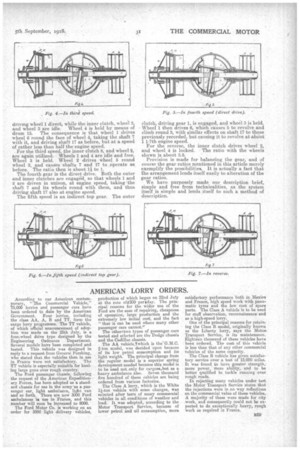A NEW CHANGE-SPEED GEAR.
Page 8

Page 9

If you've noticed an error in this article please click here to report it so we can fix it.
Constant Mesh Bevel Wheels and Clutches Employed.
AN INTERESTING, ingenious, and novel change-speed gear has recently been patented by Leyland Motors, Ltd., and Mr. J. G. P. Thomas. The latter is the patentee of the weil-known Thomas transmission. It is of the epicyclic type, five forward speeds and a reverse being arranged for, using only six gear wheels. The gearbox resembles, a differential case, and the gear is similar in principle to a differential gear, the novel feature being that the .wheels are all of different sizes. The planetary pinions are two in number. They are secured to a cross-shaft, which is carried in bearings in the main final drive-shaft of the transmission, so that motion is actually transmitted by the shaft of the planetary pinions, acting as a lever and turning the main shaft. The oross-shaft revolves round the sun wheels under the influence of the planetary pinions. The sun wheels are four in number, and their disposition may be best understood by reference to the general arrangement drawing. They are arranged so that they are capable of rota
tion about a common axis but are themselves free to rotate independently of one another. In order to enable our readers fully to understand the working of this device, we have had made a set of six special drawings showing this interesting device arranged for each of the six possible variations of gear, and also a general arrangement, to a large scale, of the gear.
The last-named drawing appears as Fig. 1.. In Fig. 2 the gear is shown in first speed. The drive is transmitted through the inner clutch cone, 8, to wheel 2, thus causing wheel 5, and with it shaft 7 and wheel 6, to revolve. As the last-named is geared with wheel 1, and wheel 1 is held from revolving through the medium of brake-drum 13, the consequence is that wheel 6 travels round shaft 17, taking with it shaft 7, and, as the last is carried in shaft 17, it follows that 1'Z. is forced to revolve in unison. Wheels 3 and 4 are free, and revolve idly, with their respective drums 14. and 15. The ratio, with the wheels shown, is'approximately 5 to 1. On second speed the outer clutch, 12, is utilized,' driving wheel 1 direct, while the inner clutch, wheel 2, and wheel 3 are idle. Wheel 4 is held by means of drum 15. The consequence is that wheel 1 drives -wheel 6 round the face of wheel 4, taking the shaft 7 with it, and driving shaft 17 as before, but at a speed of rather less than half the'engine speed. For the third speed, the inner clutch 8, and wheel 2, are again utilized. Wheels 1 and 4 are idle and free. Wheel 3 is held. Wheel 2 drives wheel 5 round wheel 3, and causes shafts 7 and 17 to _operate as before. The ratio then is about 14 to 1. The fourth gear is the direct drive. Both the outer and inner clutches are engage-41, so that wheels 1 and 2 are driven in unison, at engme speed, taking the shaft 7 and its wheels round with them, and thus driving shaft 17 also at engine speed.
The fifth speed is an indirect top gear. The outer
clutch, driving gear 1, is engaged, and wheel 3 is held. Wheel 1 then drives 6, which causes 5 to revolve and climb round 3, with similar effects on shaft 17 to those previously recorded, but causing it to revolve at about 1 1-7th engine speed. For the reverse, the inner clutch drives wheel 2, and wheel 4 is locked. The ratio with the wheels shown is about 3.5.
Provision is made for balancing the gear, and of course the gear ratios mentioned in this article merely exemplify the possibilities. It is actually a, fact that the arrangement lends itself easily to alteration of the gear ratios. We have purposely made our description brief, simple and free from technicalities, as the system itself is simple and lends itself to such a method of description.






















